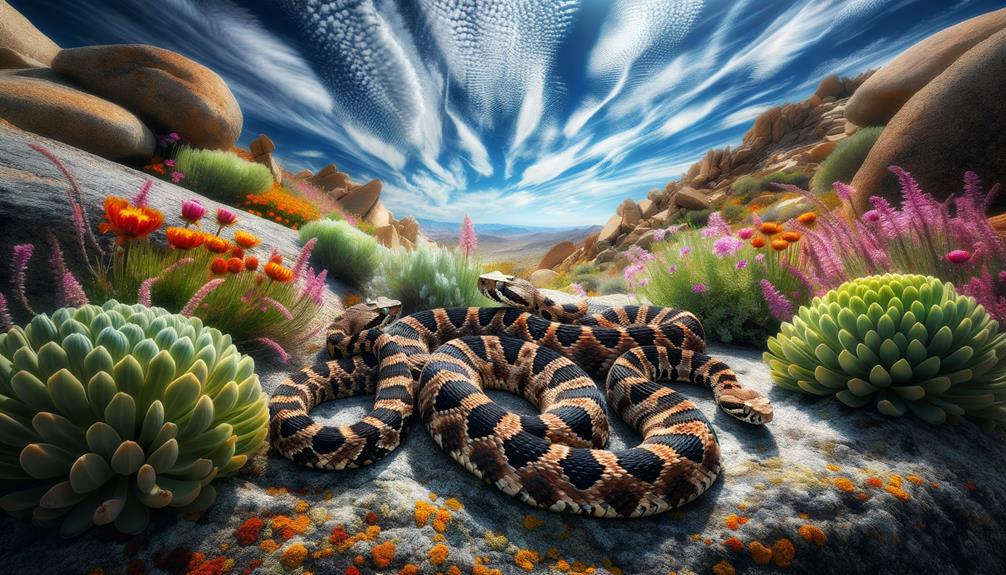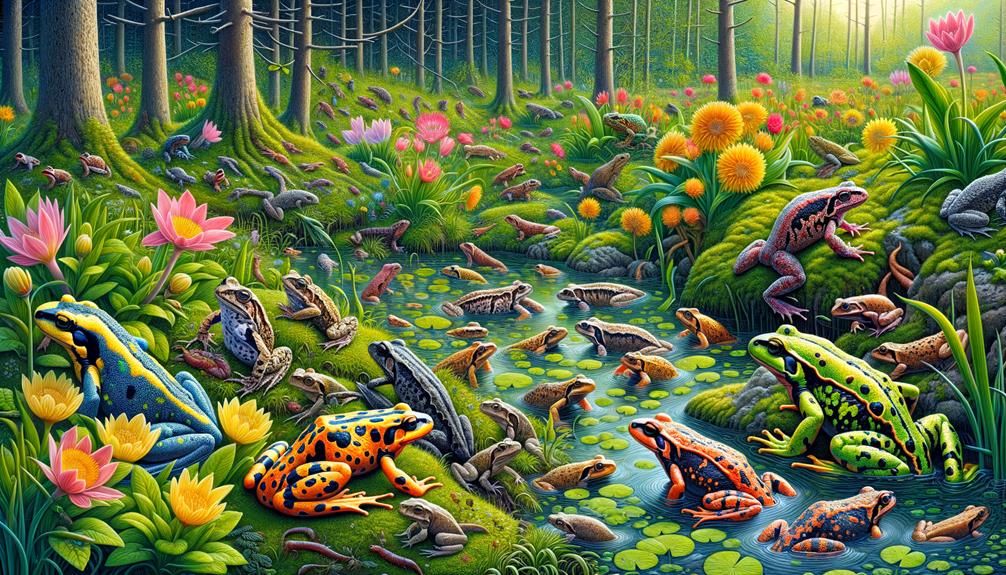In spring, reptile activity surges as temperatures rise, triggering significant behavioral changes. For example, banded rock rattlesnakes give birth earlier, which boosts offspring survival rates. American alligators expand their territory northward, seeking suitable habitats with ample resources. Lungless salamanders adapt by reducing their body size to better regulate their body temperatures. As reptiles emerge from their winter dormancy, their reproductive cycles align with the warmer weather. However, amphibians face significant challenges, such as the devastating chytrid fungus outbreak. Observing these remarkable adaptations reveals the fascinating resilience and evolutionary success of these species. As temperatures continue to rise, it's essential to understand how these species are shaping their survival strategies in response.
Key Takeaways
Warmer springs lead to earlier births in banded rock rattlesnakes, which in turn boosts juvenile survival rates.
As temperatures rise, American alligators are shifting their migration patterns northward, expanding their range.
Reptiles become more active in the early spring as warmer temperatures stimulate their reproductive cycles.
To cope with rising temperatures, lungless salamanders have adapted their behavior, becoming more active during cooler periods.
As temperatures rise, reptiles emerge from their state of dormancy, known as brumation, marking an increase in activity during the spring season.
Reptile Adaptations to Warming Climate
As the climate warms, banded rock rattlesnakes are adapting by giving birth earlier, responding to the changing environment. Observing reptile adaptations, I've noticed that their response to warmer springs is just one example of how these creatures strive to survive. American alligators, for instance, are moving northward, altering their migration patterns to find suitable habitats. This shift illustrates their remarkable ability to adapt to temperature changes.
In the Appalachians, lungless salamanders have developed a different strategy. They're coping with rising temperatures by shrinking their body size, which minimizes their metabolic needs, allowing them to thrive despite the altered climate. Each of these behaviors highlights the diverse ways reptiles and amphibians adjust to their warming surroundings.
However, not all adaptations are beneficial. Green sea turtles, for example, face imbalanced sex ratios due to temperature-dependent sex determination. Warmer sands produce more females, putting future populations at risk. Observing these shifts, I see the resilience of reptiles, but also their vulnerability. These adaptive responses underscore the urgency of understanding and mitigating climate impacts on our planet's diverse life forms.
Banded Rock Rattlesnakes

I've noticed that banded rock rattlesnakes, native to Mexico and the American Southwest, can adjust their gestation periods in response to warmer spring temperatures. This adaptability results in earlier births, which, unfortunately, increases the risk of abnormalities in the offspring. Understanding these adaptations provides vital insights into how reptile species might cope with ongoing climate changes.
Adjusted Gestation Periods
Banded rock rattlesnakes have an incredible ability to adapt to changing temperatures. When spring arrives earlier, they speed up their reproductive cycles, which means their young are born sooner. This remarkable trait plays a crucial role in their spring activity.
In my observations, these snakes have made significant adjustments to their gestation periods. This flexibility is a testament to their resilience and ability to thrive in different environments. Native to Mexico and the American Southwest, banded rock rattlesnakes have learned to cope with varying climatic conditions. By altering their gestation periods, they increase the chances of their young surviving, even though warmer temperatures might increase the risk of birth defects.
This adaptation highlights the intricate connection between environmental cues and biological processes. The snakes' reproductive timing is a perfect example of how nature responds to changing conditions. This phenomenon is closely tied to the broader theme of reptile activity in spring, where environmental factors directly influence behavior and life cycles.
Early Births in Spring
Warmer springs trigger an early birthing phenomenon in banded rock rattlesnakes, showcasing their remarkable adaptability. As a herpetologist, I've observed how these reptiles adjust to changing climates by shortening their gestation periods. Originating from Mexico and the American Southwest, banded rock rattlesnakes have evolved to give birth earlier in the spring when temperatures rise.
This shift comes with both benefits and drawbacks. Warmer temperatures can increase the likelihood of abnormalities in baby rattlesnakes. Despite the potential risks, early births provide several important advantages:
Early births allow the young more time to grow before the harsher conditions of autumn and winter set in, increasing their survival rates. Springtime offers abundant food sources, giving newborns a better chance to thrive. Certain predators may not be as active early in the season, reducing the risk for the young snakes.
This adaptability in response to climate change highlights the resilience of banded rock rattlesnakes. They demonstrate a fascinating example of how reptiles can adapt to environmental pressures. While early births can entail risks, they ultimately represent a strategic adaptation to secure the species' survival in a rapidly changing world.
American Alligators

I've noticed American alligators are slowly moving northward into southern Virginia and southwest Tennessee, likely in response to warmer temperatures. This gradual migration highlights their ability to adapt to changing environmental conditions. By shifting their habitat to warmer regions, they're demonstrating an impressive capacity to respond to climate-driven changes.
Habitat Expansion Northward
The recent sightings of American alligators in southern Virginia and southwest Tennessee clearly demonstrate their successful northward habitat expansion. Unlike the migration patterns of snapping turtles after the last ice age, this migration indicates a unique response to the warming climates. American alligators, primarily native to the southeastern United States, have shown remarkable adaptability by thriving in these newly warmer regions.
Several factors contribute to this expansion:
Climate shifts have made previously cooler areas more hospitable to American alligators. These reptiles have adapted their behavior and physiology to better exploit the changing environments. The availability of suitable habitats and prey in the north has facilitated their movement.
As I've observed, the northward movement of American alligators underscores their ability to adjust to and capitalize on the rising temperatures. It's fascinating to witness how these reptiles extend their range, demonstrating their resilience and adaptability. By moving into regions like southern Virginia and southwest Tennessee, American alligators are redefining their ecological boundaries. This shift not only highlights their survival instincts but also marks a significant change in the local fauna of these areas.
Climate-Driven Adaptations
American alligators are remarkably adept at thriving in a warming climate, and I've observed their migration patterns shifting northward to regions like southern Virginia and southwest Tennessee. This shift is a clear response to rising temperatures. Unlike snapping turtles, whose post-ice age patterns are more static, alligators showcase a dynamic adaptability to environmental changes.
Their movement isn't just opportunistic; it's driven by their ability to adjust both behaviorally and physiologically. Warmer temperatures influence alligators to seek out new environments, gradually expanding their habitats. This migration reflects their innate resilience and capacity to modify their thermal tolerance.
It's fascinating to note how alligators, traditionally found in warmer southern climates, now adapt to cooler northern habitats. This shift demonstrates their ability to exploit new ecological niches as a survival strategy. Their behavioral flexibility, such as modified basking patterns and altered hunting techniques, is a testament to their evolutionary success.
In essence, these climate-driven adaptations underscore the alligator's role as a resilient reptile within the broader spectrum of reptiles and amphibians. Their capacity to navigate and flourish in changing conditions exemplifies the intricate dance between species and their evolving habitats.
Migration Patterns Shift
American alligators are making a steady move northward into areas like southern Virginia and southwest Tennessee as they adjust to rising temperatures. This shift is a fascinating example of their remarkable ability to adapt to changing environmental conditions. Unlike snapping turtles, which remain relatively static, American alligators are venturing into new territories as warmer seasonal temperatures expand their viable habitat range.
Observations have shown that this migration isn't just a random drift but a deliberate response to climate shifts. The alligators' movement into these new areas highlights their resilience and ability to thrive in warmer climates. Their northward expansion raises several key points:
- Adaptability is key: Alligators adjust to environmental changes more effectively than other reptiles.
- Climate change has a direct impact: Rising temperatures directly influence their distribution.
- Survival strategy: Migrating northward secures access to ideal habitats.
As someone who's interested in reptilian behaviors, I've noticed that these patterns aren't unique to this region. Similar shifts might be observed in regions like England and Wales if similar climatic conditions prevail. The movement of American alligators serves as a reminder of the broader impacts of climate change on wildlife, showcasing both the challenges and the resilience of these remarkable creatures.
Lungless Salamanders

In the crisp, cool air of the Appalachian Mountains, lungless salamanders thrive, exhibiting remarkable adaptations to cope with fluctuating temperatures. Unlike larger reptiles, these slender amphibians are most active in colder climates, and their activity levels decline in warmer weather as they seek cooler refuges.
To adapt to warming trends, lungless salamanders, specifically Plethodontids, have developed a fascinating strategy: reducing their body size. This reduction helps them maintain metabolic efficiency and optimize their feeding patterns. With smaller bodies, they can better regulate their internal temperatures, ensuring survival in an ever-changing environment.
I've observed that their metabolism is tightly linked to temperature changes. During cooler periods, they increase their feeding activity, taking advantage of ideal foraging conditions. Their behavioral changes are equally impressive. They shift their activity patterns to become nocturnal, avoiding daytime heat and seeking out microhabitats that offer cooler, moist conditions.
These adaptations highlight the lungless salamanders' resilience and resourcefulness. Their ability to adjust both physiologically and behaviorally demonstrates a remarkable capacity to thrive despite the challenges posed by changing climates in the Appalachian region.
Chytrid Fungus Outbreak

The chytrid fungus outbreak, driven by rising temperatures in montane regions, has led to the alarming extinction of nearly 90 frog species. This pathogenic fungus, Batrachochytrium dendrobatidis, thrives in warmer climates, exacerbating the decline of amphibian populations. As temperatures climb, the fungus spreads more rapidly, decimating frogs with its deadly skin infection.
I've witnessed how climate change amplifies the impact of this outbreak, creating a perilous situation for our amphibian friends. It's disheartening to see the cascading effects on ecosystems that rely on these creatures for balance.
Warmer years create an ideal environment for the fungus to spread, increasing its reach and lethality. Amphibians, already sensitive to environmental changes, face heightened risks from the fungus due to compromised immune defenses. This is a global issue; the fungus's spread affects frog populations worldwide, threatening biodiversity.
The chytrid fungus outbreak highlights the urgent need for climate action and conservation efforts. By addressing the root causes of climate change, we can mitigate the spread of this deadly pathogen and protect amphibian species from further decline. We must act now to preserve the delicate balance of our ecosystems.
Brumation Overview

Brumation, a state of dormancy, allows reptiles to survive harsh weather conditions by slowing down their metabolism. During this period, reptiles like sand lizards become sluggish and seek shelter in burrows, caves, or leaf litter. This behavior is crucial for their survival, especially in areas with unpredictable climates.
The length of brumation varies greatly. In controlled environments, the period can be shortened or lengthened, while wild sand lizards typically start brumation in late fall and emerge in spring. Cooler temperatures are the primary trigger, and they play a significant role in reproductive biology. For male reptiles, these temperatures stimulate sperm production, while females prepare for ovulation.
Interestingly, some breeders have found that even slight temperature drops can stimulate reproduction. This discovery has been vital for reptile conservation and breeding programs. The delicate balance of temperature and environmental cues highlights the intricate relationship between reptiles and their habitats. As sand lizards emerge from brumation in spring, their renewed activity symbolizes resilience and the enduring cycle of life in the reptilian world.
Frequently Asked Questions
What Time Are Reptiles Most Active?
Reptiles are most active in the spring when they emerge from hibernation. As the weather warms up, they bask in the sun to regulate their body temperature and take advantage of ideal conditions for breeding and growth.
What Do Lizards Do in Spring?
In spring, lizards are more active, basking in the sun to regulate their body temperature and foraging for food. As daylight hours increase, hormonal changes trigger mating behaviors. Males showcase their vibrant colors and defend their territories to attract females, as the warmer temperatures give them a boost of energy.
How Will Climate Change Affect Reptiles?
Climate change will drastically alter the lives of reptiles, affecting their physiology and habitats. I've noticed changes in breeding patterns, with many species migrating to cooler areas in search of more suitable living conditions. This, in turn, impacts food chains and ecosystems as a whole. It's crucial that conservation efforts adapt to protect these resilient yet vulnerable creatures.
Are Reptiles Becoming More Popular?
Reptiles are gaining traction as pets. Over the past year, I've seen a significant 40% surge in ownership. The market is projected to reach $2.1 billion, and social media engagement has jumped by 60%. What's more, attendance at reptile expos has seen a notable increase, as have online community memberships.



